
About UsThe Numismatic Bibliomania Society is a non-profit organization promoting numismatic literature. For more information please see our web site at coinbooks.org SubscriptionsThose wishing to become new E-Sylum subscribers (or wishing to Unsubscribe) can go to the following web page link MembershipThere is a membership application available on the web site Membership Application To join, print the application and return it with your check to the address printed on the application. Membership is only $15 to addresses in the U.S., $20 for First Class mail, and $25 elsewhere. For those without web access, write to: David M. Sundman, Secretary/TreasurerNumismatic Bibliomania
Society AsylumFor Asylum mailing address changes and other membership questions, contact David at this email address: dsundman@LittletonCoin.com SubmissionsTo submit items for publication in The E-Sylum, just Reply to this message, or write to the Editor at this address: whomren@coinlibrary.com
BUY THE BOOK BEFORE THE COINYou won't regret it! |
- WAYNE'S WORDS: THE E-SYLUM JULY 6, 2008
- CUMULATIVE INDEX TO THE ASYLUM, 1980-2007
- UPDATE: 100 GREATEST WORKS OF AMERICAN NUMISMATIC LITERATURE
- REVIEW: NATIONAL COMMEMORATIVE MEDALS OF THE UNITED STATES
- AUTHOR'S UPDATE ON "EARLY UNITED STATES QUARTERS 1796 - 1838"
- NEW BOOK: GUIDE BOOK OF UNITED STATES PAPER MONEY, 2ND EDITION
- AUGSBURGER'S "TREASURE IN THE CELLAR" BOOK AVAILABLE IN THREE FORMATS
- GUIDE BOOK OF SOUTHERN STATES CURRENCY WINS SPMC BOOK AWARD
- WIZARD SUPPLY TO DISTRIBUTE RENAISSANCE OF AMERICAN COINAGE BOOKS
- J. ROY PENNELL, JR. 1924-2008
- AUGUST 2008 ISSUE OF THE COLONIAL NEWSLETTER PUBLISHED
- LATEST PAPER MONEY HIGHLIGHTS RECENT SCHOLARSHIP
- ARTICLE EXPLORES ORIGINS OF FRANKLIN, WASHINGTON AND HUME MEDALS
- QUERY: FREEZING WATER-DAMAGED BOOKS
- MORE ON THE JAMESTOWN, N.D. DOLLAR AND OTHER TERRITORIAL PIECES
- MORE ON THE MUSEUM / COLLECTOR DEBATE
- QUERY: SCRANTON, PA LINCOLN MONUMENT MEDAL SOUGHT
- QUERY: NUMBER OF PLATES IN THE NEWCOMB DELUXE LEATHER EDITION
- MARKETING COMPANY REPRODUCES $100 UNION COIN DESIGN IN SILVER
- TV'S "HISTORY DETECTIVES" EXAMINE COIN SHOT BY ANNIE OAKLEY
- GARRETT 1854 KELLOGG $20 PROOF TO BE DISPLAYED AT BALTIMORE ANA
- UNDER PRESSURE, GERMAN FIRM STOPS BANKNOTE PAPER SALE TO ZIMBABWE
- ROBERT LEUVER ON SECRET BANKNOTE PRINTING OPERATIONS
- BULLET CLUBS: ANOTHER THEORY ON THE ORIGIN OF MILITARY CHALLENGE COINS
- PERFECT CRIME? WHEN IS A FAKE BANKNOTE NOT A FAKE?
- POEM: BOOKS TO THE CEILING BY ARNOLD LOBEL
- FEATURED WEB PAGE: COLD WAR AND INSURGENCY PROPAGANDA BANKNOTES
WAYNE'S WORDS: THE E-SYLUM JULY 6, 2008
 Among our recent subscribers are Lowell
Horwedel, courtesy of John and Nancy Wilson, Traci Poole and Tony Hine.
Welcome aboard! We now have 1,156 subscribers.
Among our recent subscribers are Lowell
Horwedel, courtesy of John and Nancy Wilson, Traci Poole and Tony Hine.
Welcome aboard! We now have 1,156 subscribers.This week we open with a note about the new cumulative index to The Asylum and an update on the balloting for NBS' list of the greatest works of American numismatic literature. Next, Dick Johnson reviews the new book on national Commemorative Medals.
Other new books discussed this week include Len Augsburger's Treasure in the Cellar, Steve Tompkins' book on early U.S. quarter dollars, and two works from Whitman Publishing on paper money.
In items inspired by previous E-Sylum discussions, we cover freezing water-damaged books, U.S. territorial tokens, and the debate over donating collections to museums. Queries this week cover topics including the deluxe Newcomb on large cents.
In the new, the History Detectives examine a coin said to be shot by Annie Oakley, and a German banknote firm bows to pressure and stops supplying banknote paper to the Zimbabwe government.
To learn what makes a Good-For token worth over $5,000, read on. Have a great week, everyone.
Wayne Homren
Numismatic Bibliomania Society
CUMULATIVE INDEX TO THE ASYLUM, 1980-2007
 Although E-Sylum subscriptions are free to all,
only paid members of the Numismatic Bibliomania Society receive The
Asylum, our quarterly print publication. The latest copy (Volume 26,
Number 2) arrived in my mail box this week, together with a special
Volume 25 Supplement, a cumulative index of The Asylum from
1980 through 2007.
Although E-Sylum subscriptions are free to all,
only paid members of the Numismatic Bibliomania Society receive The
Asylum, our quarterly print publication. The latest copy (Volume 26,
Number 2) arrived in my mail box this week, together with a special
Volume 25 Supplement, a cumulative index of The Asylum from
1980 through 2007.Compiled by William Malkmus, the index spans 52 pages of entries, organized by Author and Subject headings. NBS and numismatic bibliophiles and researchers in general owe Bill was thunderous round of applause for his dogged multiyear effort to create and maintain the index of this important publication. E-Sylum readers are missing out if they don’t sign up as NBS members. For membership information, see the box at the top right of each E-Sylum. The latest issue (April-June 2008) contains these articles:
- Richard Jozefiak - Picture Postcard Set Tells the Story of Early Twentieth-Century British Royal Mint Coin Production
- Henry Morris - The Making of the Special Edition of Adams' and Bentley's Comitia Americana and Related Medals
- John W. Adams - The Medals of Admiral Vernon: A Bibliography
- Leonard Augsburger - Book Review: From Gothic Windows to Peacocks: American Embossed Leather Bindings, 1825-1855, by Edwin Wolf
UPDATE: 100 GREATEST WORKS OF AMERICAN NUMISMATIC LITERATURE
Regarding the balloting among Numismatic Bibliomania Society member for the 100 Greatest Works of American Numismatic Literature, Len Augsburger writes:REVIEW: NATIONAL COMMEMORATIVE MEDALS OF THE UNITED STATES
The author also illustrates a wide variety of associated items in color: leaflets, stamps, tickets, badges, first day covers, postal cards, medal envelopes, order forms, expo certificates, and in one case, a painting and paper money showing the same design as on the medal. Associated items amplify the meaning and importance of the medal with these items, usually collectors' items in themselves.
To the author's credit he has unearthed data not elsewhere found in numismatic literature. He did extensive research on national medals, those medallic items issued by the government for a wide variety of purposes, most often for American expositions, the inevitable "official medal" because of the government issue imprimatur.
But the book cries for an editor, and perhaps a book designer. The author apparently did these functions himself as self publisher. Just because your computer allows you to do many varied things doesn't mean you have to do this in a formal work. Someone should have dissuaded the author from his frequent use of lines of text in colors, frequent underlining of text and headlines, numerous lines of differing sizes, odd type faces at times trying to match type style on medals, and a spreadsheet index. There are customs in book publishing. This book has veered off the road in too many ways.
The numbering takes some effort to get used to as well. The author chose a sequence number system where the Events are numbered -- there are 53 such events -- catalog numbers 1 to 53. Then varieties are assigned large Roman numerals. Subvarieties are given lowercase letters and superscript numbers. Rather confusing. He must have recognized this himself when he got to event number 11 and the third variety. He had to insert a hyphen or else he would have had 11III (like a row of columns!). Thank goodness it did not have a subvariety.
There are 79 medals covered in this 300-page book. After the 53 national events, part 2 covers those medals issued by government agencies (they are numbered 201 to 208), part 3 are medals to honor memorials (301 to 308), and part 4 are for private organizations (401 to 409).
The author has updated the previous listing of these medals (by Howard L. Turner, Commemorative Medals Struck at the United States Mint which appeared in the July 1968 issue of The Numismatist and a second installment in the September 1977 issue). Bill Swoger's text is in uniform format: the authorizing act, the event's history, the ceremony, the medal. Every medal is described.
Without question the author was very concerned with accuracy throughout the work. I have yet to find a factual error. I was uncomfortable, however, with the spreadsheet index. I noticed some names were not indexed, while similar ones were.
You will enjoy the color illustrations and the book's accuracy. And if you do not like the exuberant price, get on the waiting list to borrow this book at the ANA library.
AUTHOR'S UPDATE ON "EARLY UNITED STATES QUARTERS 1796 - 1838"
Steve Tompkins writes: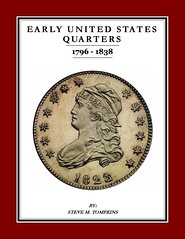 I just wanted to say thank you to all the
E-Sylum readers who have already sent payment for the pre-publication
offering of my new book, Early United States Quarters 1796 - 1838.
The printed signatures should be at the binders this week, with hopefully
a small quantity of the finished books being available at the upcoming ANA
convention. I also wanted to remind anyone who has been procrastinating in
placing their order (and you know who you are!), that after July 15 the
price will be raised to the cover price of $89.00 plus postage. Any order
postmarked by the 15th of July will be taken at the pre-publication price
of $79.00 delivered. Please send all payments to the address listed below:
Steve Tompkins
I just wanted to say thank you to all the
E-Sylum readers who have already sent payment for the pre-publication
offering of my new book, Early United States Quarters 1796 - 1838.
The printed signatures should be at the binders this week, with hopefully
a small quantity of the finished books being available at the upcoming ANA
convention. I also wanted to remind anyone who has been procrastinating in
placing their order (and you know who you are!), that after July 15 the
price will be raised to the cover price of $89.00 plus postage. Any order
postmarked by the 15th of July will be taken at the pre-publication price
of $79.00 delivered. Please send all payments to the address listed below:
Steve Tompkins P.O. Box 1946
Sequim, WA 98382
NEW BOOK: GUIDE BOOK OF UNITED STATES PAPER MONEY, 2ND EDITION
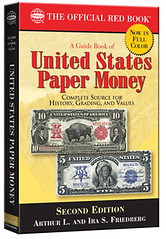 In the 416 pages of this fully updated new
edition, the history buff is treated to a study of American currency from
the War of Independence to the modern day. The art aficionado, meanwhile,
is immersed in full-color galleries of the beautiful, ornate, richly
symbolic artistry of American paper money. Currency collectors have, in
the Friedberg numbering system, the perfect system for cataloging their
collections. Sellers and buyers alike benefit from the book’s retail
valuations across several grades for each series.
In the 416 pages of this fully updated new
edition, the history buff is treated to a study of American currency from
the War of Independence to the modern day. The art aficionado, meanwhile,
is immersed in full-color galleries of the beautiful, ornate, richly
symbolic artistry of American paper money. Currency collectors have, in
the Friedberg numbering system, the perfect system for cataloging their
collections. Sellers and buyers alike benefit from the book’s retail
valuations across several grades for each series.It’s easy to see why the first edition of the Guide Book won a Numismatic Literary Guild award (“Best Specialized Book, U.S. Paper Money,” 2005). Now the second edition carries on that tradition. Every federal note—from the ultra rare Demand Notes of 1861 to the lunch money in our wallets today—is described in detail in this new volume. Also given full treatment are War of 1812 Treasury Notes, encased postage stamps, Fractional Currency, and error notes. Fascinating narrative captures the history of American paper money, and also explores recent developments in the hobby and market.
To read the complete article, see: Collecting the Nation’s Wealth (http://www.whitmanbooks.com
ReviewFBook2_0708)
AUGSBURGER'S "TREASURE IN THE CELLAR" BOOK AVAILABLE IN THREE FORMATS
 Treasure in the Cellar, the story of the
Baltimore gold hoard of 1934, published by the Maryland Historical
Society, is now available in three formats. Ordering options are as
follows: 1) The deluxe version comes in half leather, with marbled end
paper, raised spine bands and gilt pages (images attached). Ten copies
were prepared by Kater-Crafts Bookbinders of Pico Rivera, CA. Priced at
$295, postpaid. Email to leonard_augsburger@hotmail.com to order a copy.
Treasure in the Cellar, the story of the
Baltimore gold hoard of 1934, published by the Maryland Historical
Society, is now available in three formats. Ordering options are as
follows: 1) The deluxe version comes in half leather, with marbled end
paper, raised spine bands and gilt pages (images attached). Ten copies
were prepared by Kater-Crafts Bookbinders of Pico Rivera, CA. Priced at
$295, postpaid. Email to leonard_augsburger@hotmail.com to order a copy.
2) The regular hardbound version is priced at $33 postpaid and may be ordered via the same email address.
3) The card cover version can be ordered from Amazon, priced at $17.16. The Amazon link is http://www.amazon.com/Treasure
For more information, see: www.TreasureInTheCellar.com/
GUIDE BOOK OF SOUTHERN STATES CURRENCY WINS SPMC BOOK AWARD
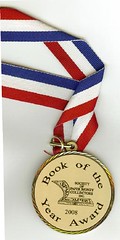 The Society of Paper Money Collectors awarded
Hugh Shull its 2008 “Book of the Year” medal, for the Guide Book of
Southern States Currency (Whitman Publishing, 2007). The award was
presented in June at the Memphis International Paper Money
Show.
The Society of Paper Money Collectors awarded
Hugh Shull its 2008 “Book of the Year” medal, for the Guide Book of
Southern States Currency (Whitman Publishing, 2007). The award was
presented in June at the Memphis International Paper Money
Show.“This is a wonderful honor to be recognized by my peers in the hobby community,” said Shull.
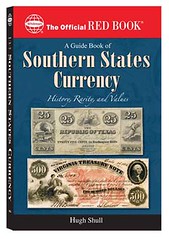 The SPMC award is the third won by Shull for
Southern States Currency. The book also received the 2007 Professional
Currency Dealers Association’s Literary Award and a 2007 Extraordinary
Merit award from the Numismatic Literary Guild.
The SPMC award is the third won by Shull for
Southern States Currency. The book also received the 2007 Professional
Currency Dealers Association’s Literary Award and a 2007 Extraordinary
Merit award from the Numismatic Literary Guild.Shull’s book is an authoritative guide to the state-issued money of the South, from the pre–Civil War era through the war years, and into the late 1800s. It combines his research and first-hand knowledge of the market with historical text by Wendell Wolka. Detailed descriptions, hundreds of full-color images, and valuations in multiple grade levels add to its value for the historian and the collector.
WIZARD SUPPLY TO DISTRIBUTE RENAISSANCE OF AMERICAN COINAGE BOOKS
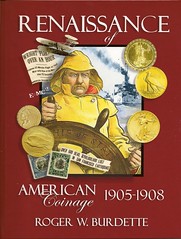 Wizard Coin Supply and Seneca Mill Press LLC
proudly announce the appointment of Wizard Coin Supply as the exclusive
distributor for the Renaissance of American Coinage books by Roger W.
Burdette. All three deluxe, hard cover research books have been the
recipients of acclaim from numismatic professionals and collectors
nationwide. The Renaissance of American Coinage series consists of:
Renaissance of American Coinage 1905-1908 (Saint-Gaudens/Theodore
Roosevelt collaboration and new gold coinage designs); Renaissance of
American Coinage 1909-1915 (Lincoln Cent, Buffalo Nickel and Panama
Pacific commemoratives); and, Renaissance of American Coinage
1916-1921(Mercury Dime, Standing Liberty Quarter, Walking Liberty Half
Dollar and Peace dollar).
Wizard Coin Supply and Seneca Mill Press LLC
proudly announce the appointment of Wizard Coin Supply as the exclusive
distributor for the Renaissance of American Coinage books by Roger W.
Burdette. All three deluxe, hard cover research books have been the
recipients of acclaim from numismatic professionals and collectors
nationwide. The Renaissance of American Coinage series consists of:
Renaissance of American Coinage 1905-1908 (Saint-Gaudens/Theodore
Roosevelt collaboration and new gold coinage designs); Renaissance of
American Coinage 1909-1915 (Lincoln Cent, Buffalo Nickel and Panama
Pacific commemoratives); and, Renaissance of American Coinage
1916-1921(Mercury Dime, Standing Liberty Quarter, Walking Liberty Half
Dollar and Peace dollar). Currently boasting one of the largest selections of coin books and coin collection supplies in the numismatics industry, Wizard Coin Supply adds to its already impeccable reputation with the addition of the Renaissance series. "This is an important advance in the distribution of these ground breaking research books," commented author Roger Burdette. "Wizard Coin Supply brings a wealth of talent and distribution access to the numismatic community that will increase the availability of these works to collectors."
The Renaissance series, printed in the United States, is recognized by savvy collectors as a landmark compilation of numismatic research. The 1916-1921 and 1905-1908 volumes in the series were awarded with Numismatic Literary Guild Book of the Year Awards in 2006 and 2007 respectively, while the 1909-1915 volume will be considered for the same accolade later this summer. The early twentieth century coin era explored in the books is generally considered to be one of the most exciting in the history of United States coinage. "The degree of exhaustive research and original analysis that defines the Renaissance series is unique among numismatic literature," notes Sir Wayne Herndon (Wizard eschews traditional titles in favor of thematic ones) responsible for production selection at Wizard Coin Supply. "Roger was particularly careful to avoid merely regurgitating prior works which, in many instances, serves to perpetuate misinformation and popular myths within numismatics."
"Becoming the official and exclusive distributor of the Renaissance series is yet another way that we are delivering the very best in numismatics literature to our discerning customers," said Wizard's Lady Karin Herndon. "We believe the books of the Renaissance series thoroughly capture the excitement of the coin design and artistry of the early twentieth century - perhaps the most significant period of coin design in U.S. history." Beginning on July 1, 2008, all orders for books in the Renaissance series should be made directly through Wizard Coin Supply.
J. ROY PENNELL, JR. 1924-2008
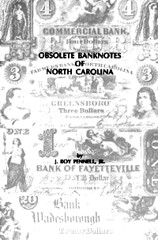 Probably in the late 1990's Roy had Dr. Jack
Vorhie's share or be at the table with him. Dr. Vorhies passed away in
2007. Roy's contributions to the numismatic hobby are not well known
outside the Syngraphic area. He was an author of the Obsolete Banknotes of
North Carolina published in 1966 in Anderson, SC. Mr. Pennell was an avid
collector of South Carolina obsolete notes. He also reprinted some
counterfeit detectors from the obsolete era. Roy also reprinted a Rawdon,
Wright, Hatch & Edson sheet which contained many different vignettes,
denominations and ornaments of all kinds. We think 998 were produced in
the middle 1980's by Roy. The ABNCo used the original plate to produce the
sheets. One is framed on our wall in our home.
Probably in the late 1990's Roy had Dr. Jack
Vorhie's share or be at the table with him. Dr. Vorhies passed away in
2007. Roy's contributions to the numismatic hobby are not well known
outside the Syngraphic area. He was an author of the Obsolete Banknotes of
North Carolina published in 1966 in Anderson, SC. Mr. Pennell was an avid
collector of South Carolina obsolete notes. He also reprinted some
counterfeit detectors from the obsolete era. Roy also reprinted a Rawdon,
Wright, Hatch & Edson sheet which contained many different vignettes,
denominations and ornaments of all kinds. We think 998 were produced in
the middle 1980's by Roy. The ABNCo used the original plate to produce the
sheets. One is framed on our wall in our home. Few know this, but Roy also handled the sales of the ABNCo produced Souvenir Cards for the Society of Paper Money Collectors (SPMC). He handled that project for several years. We took it over in the 1980's from Roy and handled the sales for the SPMC for several years until the program ended.
We knew J. Roy Pennell, Jr. as a Dealer, Collector, Author, Speaker, Researcher and Coin Club Officer. Mr. Pennell served in several capacities for the SPMC. He was Secretary from 1964-1967; Second Vice-President from 1969-1971 and President from 1971-1975. He also wrote many articles for the SPMC publication Paper Money. He joined the American Numismatic Association in 1945. Mr. Pennell donated many rare items to the ANA over the years. He also donated to the American Numismatic Society. In 1985 the ANA awarded him their Medal of Merit and in 1998 the President's Award. Probably among others he received the SPMC Nathan Gold Memorial Award in 2006. He served on the U. S. Assay Commission in 1969.
Though Mr. Pennell had a stroke probably 20 years ago, it didn't stop him from taking a table at the annual paper money convention in Memphis. It was always nice to stop by his table and say "Hi" to him and look through his material. We remember about 15 years ago Roy started to bring out some very rare notes for sale. He had many Plate Proofs of U. S. notes as well as hundreds of Proof Obsolete Notes. He had many hundreds if not thousands of Die Proof Vignettes. We have probably a half dozen die proof vignettes that match up to obsolete notes we purchased from Roy. Our checkbook that year took a major hit, and it took us at least a year to pay Roy off for the material we purchased.
You will find below a link to his Obituary from the local newspaper, the Greenville News. Roy was a gentle, knowledgeable, friendly and dedicated numismatist who gave not only his talents and donations to the numismatic community, but also to the community he was a life long resident of. He will be missed by his many hundreds of friends in the numismatic community. We have made a donation to the ANA in his memory. All of our prayers and thoughts to his wife Arden and the rest of the Pennell family. Rest in Peace Roy, your memory will live on forever. To read the complete article, see: J. Roy Pennell Jr. (http://www.greenvilleonline
Category=OBITUARIES&pagename
- Gwynne & Day, Descriptive Register of Genuine Bank Notes, 1862
- Hodges, Edward, Hodges' American Bank Note Safeguard
Click on the Title page below, then click "All Sizes" to see a larger image. Look closely and you'll see a note that the original from which the reprint was made was in the Eric P. Newman numismatic library.
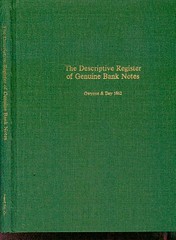
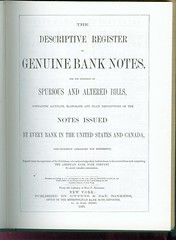
AUGUST 2008 ISSUE OF THE COLONIAL NEWSLETTER PUBLISHED
We start with a Technical Note from Clem Schettino where he reports on three new What'sIt?s, all created from genuine New Jersey coppers. A What'sIt? is a state copper where the original design was altered by a skilled engraver often resulting in a new variety. Clem reviews the previously recorded specimens and then presents the three new unreported New Jersey What'sIt?s. Images are provided of each specimen along with metrological data.
Frank Campbell, the longtime and highly respected ANS librarian, retired earlier this year. John Kleeberg, who worked with Frank, has written an appreciation of Frank and his career at the ANS Library. Integrated into the paper, John also provides suggestions on how a numismatic researcher can get the most out of the ANS Library. John's insights and recollections truly make interesting reading.
Next we are pleased to welcome a new author, Oliver D. Hoover, to the pages of CNL. Oliver is well known to many CNL readers through his published work in other ANS publications. Oliver's first contribution to CNL is an in-depth study of the Wood 33 copper. This halfpenny-sized copper is often associated with Canadian blacksmith coppers because it was included in the 1910 study of blacksmiths by Howland Wood. Over the years, however, many numismatists have come to realize that Wood 33 is more closely related to British evasion coppers than it is to Canadian blacksmiths. Oliver's groundbreaking study comes to the same conclusion - Wood 33 should be considered an imported evasion copper into Canada rather than a Canadian-made blacksmith.
Our final paper delves into the Potosí Mint scandal of the mid-1600s and its possible influence on the creation and operation of the Massachusetts Bay Mint. Authored by Dr. Philip Mossman in his never ending quest to improve upon his book Money of the American Colonies and Confederation, Phil studies the Potosí scandal and its effect upon the world's currency standard. In his book he had speculated that some of the questionable money consigned to the Massachusetts Bay Mint was from the Potosí scandal of 1648. However, based upon his current study of the scandal he has found that his original hypothesis needs to be revised. Anyone with an interest in Spanish-American coinage will find Phil's latest work very interesting and informative.
CNL is published three times a year by The American Numismatic Society, 75 Varick St., 11th Floor, New York, NY 10013. For inquires concerning CNL, please contact Megan Fenselau at the preceding postal address or e-mail fenselau@amnumsoc.org or telephone (212) 571-4470 ext. 1311.
LATEST PAPER MONEY HIGHLIGHTS RECENT SCHOLARSHIP
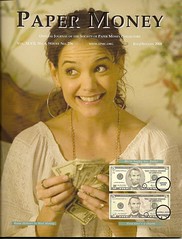 The latest issue of Paper Money, the
official publication of the Society of Paper Money Collectors (July/August
2008, Whole No. 256) highlights the recent work of several paper money
researchers. The cover article by editor Fred L. Reed III focuses on the
Stage Money used in the recent film Mad Money.
The latest issue of Paper Money, the
official publication of the Society of Paper Money Collectors (July/August
2008, Whole No. 256) highlights the recent work of several paper money
researchers. The cover article by editor Fred L. Reed III focuses on the
Stage Money used in the recent film Mad Money. The lead article by Kristin Aguilera covers the opening of the new location of the Museum of American Finance in New York City. An article by Donn Pearlman highlights Operation Bernhard counterfeit notes.
I've been a member of SPMC since about 1980 and have always enjoyed the periodical. Under Fred's editorship it keeps getting better an better. Numismatic bibliophiles should be sure to check our Fred's "Editor's Notebook" column - this issue mentions upcoming paper money books by Steve Whitfield (Kansas paper money), Neil Shafer (panic scrip), Eric Newman (early U.S. currency), and Fred himself (two books: one on Lincolniana and the other a 2nd edition of his encased postage stamp book.
ARTICLE EXPLORES ORIGINS OF FRANKLIN, WASHINGTON AND HUME MEDALS
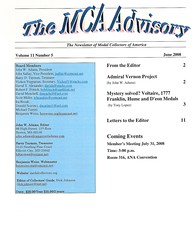 The latest issue of The MCA Advisory
(Volume 11, No. 5, June 2008) features a great article by Tony Lopez
exploring the connections between three important eighteenth century
medals:
The latest issue of The MCA Advisory
(Volume 11, No. 5, June 2008) features a great article by Tony Lopez
exploring the connections between three important eighteenth century
medals:- 1776 David Hume
- 1777 Franklin of Philadelphia
- 1778 Washington "Voltaire"
Tony had learned of a possible connection between the medals while reading John Adams and Anne Bentley's Comitia Americana book. His detailed article (illustrated with color images and closeups) proves the connection and posits a common source.
The MCA Advisory is a great source of information for researchers and is interesting to read. Where else will you see the word "immixtion" in print? For more information, see: www.medalcollectors.org
THE BOOK BAZARRE
QUERY: FREEZING WATER-DAMAGED BOOKS
Scott Semans writes:I asked Anne Bentley of the Massachusetts Historical Society, who writes:
http://aic.stanford.edu/jaic
MORE ON THE JAMESTOWN, N.D. DOLLAR AND OTHER TERRITORIAL PIECES
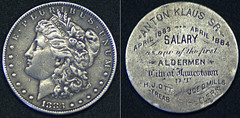 About that Anton Klaus Jamestown, D.T. engraved
Morgan dollar that was obtained in Orlando, FL - the most important aspect
of that dollar was the reference to D.T. - Dakota Territory. Had it just
said North Dakota or N.D. , it would have been just another interesting
and rare engraved dollar worth perhaps $100. With the use of D.T., the
territorial appellation becomes operative and its value is multiplied by
perhaps 10x.
About that Anton Klaus Jamestown, D.T. engraved
Morgan dollar that was obtained in Orlando, FL - the most important aspect
of that dollar was the reference to D.T. - Dakota Territory. Had it just
said North Dakota or N.D. , it would have been just another interesting
and rare engraved dollar worth perhaps $100. With the use of D.T., the
territorial appellation becomes operative and its value is multiplied by
perhaps 10x.I distinctly recall years ago seeing or examining either this D.T. engraved dollar or one of the other dozen or so made. No question about it.
 On a related note, a little Dayton, Washington
Territory Good-For trade token sold on July 3rd for $5,852 on eBay (see
item #170233628847). The eBay seller, a couple in their
70's, had no idea what they had. NO Washington Territory tokens had been
sold on eBay since its inception 10 yrs ago.
On a related note, a little Dayton, Washington
Territory Good-For trade token sold on July 3rd for $5,852 on eBay (see
item #170233628847). The eBay seller, a couple in their
70's, had no idea what they had. NO Washington Territory tokens had been
sold on eBay since its inception 10 yrs ago. The last Washington Territory token to sell was in 2002 for $3,465, at a NATCA Omaha auction . Next to Idaho, Washington Territory is the rarest territory for known tokens with the self-evident territorial designation. There are only about eight different "self-evident" Washington Territory tokens known. This latest piece was previously unknown and unlisted in Al Erickson's massive 1998 Wash trade token tome, Washington Trade Tokens. $5,852 is not a record price for a trade token, although it may be on eBay. Some "Good-Fors" have exceeded $12,000 privately.
MORE ON THE MUSEUM / COLLECTOR DEBATE
Web site visitor Jeff Dennis writes:I was an antiquarian book dealer for fifteen years and was initially scandalized by librarians casually selling donated collections of rare material at pennies on the dollar to raise funds for popular fiction, until I realized this syndrome is the rule everywhere, at every level of value.
Unlike most of my colleagues, I could never bring myself to cultivate librarians and volunteers at book sales to take advantage of it. But, I came to understand that it is always going to come with the territory, given the job mobility of librarians and curators, and the fact that the items entrusted to their care, like the neglected property of the "state" in the old soviet block, do not really belong to any one person.
I used to advise collectors who wanted to bequeath their life's efforts to an institution to have their attorneys write an iron clad contract specifying care and feeding of their collections, and endowing a fund to do so, but as you point out, even that will not protect items in a vault from thieves when the new guardian is unknowledgeable, incompetent, or simply does not care.
I think now that giving the collection to an institution is often worse than leaving it to an irresponsible son in law. It is better than hearing the ephemera has all been hauled off to the dump, which I have encountered more frequently than I care to think about.
At least when the son in law sells it off to dealers, it goes back into the collector community, who are the people who care most about preserving it. I now advise collectors to leave their collections to their biggest rival, along with an iron clad contract that he lend it to an institution.
QUERY: SCRANTON, PA LINCOLN MONUMENT MEDAL SOUGHT
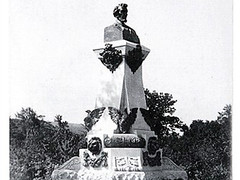 As we approach
the bicentennial of Abe's birth all kinds of Lincoln lore is coming to the
surface. Here is a news story that we did not expect. A Lincoln Monument
in Scranton, Pennsylvania is missing.
As we approach
the bicentennial of Abe's birth all kinds of Lincoln lore is coming to the
surface. Here is a news story that we did not expect. A Lincoln Monument
in Scranton, Pennsylvania is missing. Historians in the area learned about the monument with a Lincoln Bust atop an elaborately detailed base from a post card illustrating it a local collector's possession. While I don't expect an E-Sylum reader to know the whereabouts of the missing monument, does anyone have a medal issued for the dedication of this monument? It was common practice in the 19th century to issue a medal for such a ceremony. If so a medal might document an important clue. To read the story and see the post card picture, see: Pennsylvania Historians Hunt for Vanished Lincoln Monument () http://www.foxnews.com/story/0
QUERY: NUMBER OF PLATES IN THE NEWCOMB DELUXE LEATHER EDITION
NBS Member Christopher Roe writes:MARKETING COMPANY REPRODUCES $100 UNION COIN DESIGN IN SILVER
 Nick Graver forwarded an advertisement from the
June 30, 2008 issue of Forbes magazine. The ad is for a silver round with
a design copied from sketches in the National Numismatic Collection of the
proposed $100 Union coin. "New York Mint Ltd" is the purveyor of the
piece, offered in the ad for $99 plus shipping and handling.
Nick Graver forwarded an advertisement from the
June 30, 2008 issue of Forbes magazine. The ad is for a silver round with
a design copied from sketches in the National Numismatic Collection of the
proposed $100 Union coin. "New York Mint Ltd" is the purveyor of the
piece, offered in the ad for $99 plus shipping and handling.I hadn't noticed the ad, which incorporated the Smithsonian Institution logo and states that "a portion of sales proceeds of this licensed product supports the chartered educational purposes of the National Numismatic Collection, located in the Smithsonian's National Museum of American History."
Has anyone seen these? I'm curious about their quality, who cut the dies, and where the pieces were made. I contacted Dick Doty at the Smithsonian and he confirmed that these are indeed marketed as part of a deal with the National Numismatic Collection. He also put me in touch with Karen Lee, who writes:
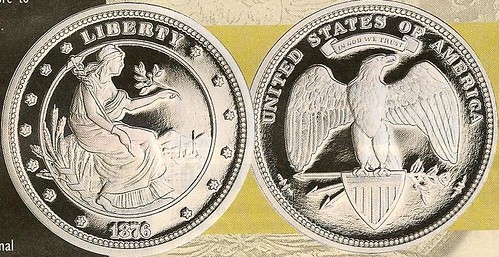
TV'S "HISTORY DETECTIVES" EXAMINE COIN SHOT BY ANNIE OAKLEY
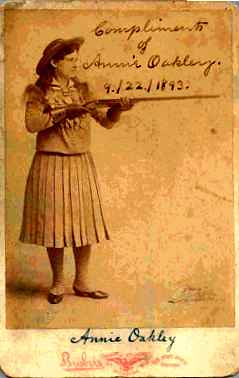
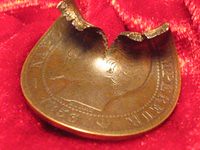 They'd make a good league of superheroes:
Bookish professors and appraisers by day whose alter egos answer calls for
help from the public during the summer break and put their well-honed
skills to use for the good of all.
They'd make a good league of superheroes:
Bookish professors and appraisers by day whose alter egos answer calls for
help from the public during the summer break and put their well-honed
skills to use for the good of all.At a time when a generation is growing up thinking that research begins and ends with Google, getting out to see actual historical records is important, Luray says.
"You have to go through the records yourself, so you can look at the footnotes that will lead you to the next clue," she said. "The best part of the archives is you can find something you would overlook on the computer. You're always discovering something."
In tonight's premiere, Luray looks into whether a family heirloom, a French coin, was indeed shot by Annie Oakley, as family legend had it.
"Everybody has family folklore," Luray says. "We show how folklore connects to American history."
To read the complete article, see: 'History Detectives' Comes To Hartford For Investigation (http://www.courant.com/entertai
GARRETT 1854 KELLOGG $20 PROOF TO BE DISPLAYED AT BALTIMORE ANA
George Fuld writes:
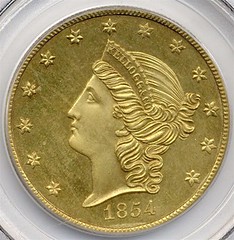 A one-of-a-kind California Gold Rush coin,
preserved for years by one of Baltimore's most prominent families, will
return here next month for the first time in nearly 30 years.
A one-of-a-kind California Gold Rush coin,
preserved for years by one of Baltimore's most prominent families, will
return here next month for the first time in nearly 30 years.The 154-year-old $20 gold piece known as the Kellogg Twenty - now worth $3 million - will be displayed during the American Numismatic Association World's Fair of Money in the Baltimore Convention Center from July 30 to Aug. 2. Once owned by Baltimore resident and diplomat John Work Garrett, the coin is considered by collectors to be one of the finest American coins from the mid-19th century.
The coin was made Feb. 9, 1854, by John Glover Kellogg, a New York native who worked as an assayer - someone who tests minerals to determine their composition - during the California Gold Rush.
The coin will be displayed from 10:30 a.m. to 6:30 p.m. July 30 through Aug. 1, and from 10 a.m. to 2 p.m. Aug. 2. The event is free and open to the public.
To read the complete article, see: Piece of Gold Rush back in town (http://www.baltimoresun.com
UNDER PRESSURE, GERMAN FIRM STOPS BANKNOTE PAPER SALE TO ZIMBABWE
 Last we discussed the German banknote firm that
was being criticized for supplying banknote paper to the regime of Robert
Mugabe in Zimbabwe, where mind-boggling inflation has reduced the
population to desperate poverty. On Tuesday the Wall Street Journal and
other publications put a spotlight on the firm, which announced that it
was giving in to the pressure and halting its shipments of banknote paper
to the country.
Last we discussed the German banknote firm that
was being criticized for supplying banknote paper to the regime of Robert
Mugabe in Zimbabwe, where mind-boggling inflation has reduced the
population to desperate poverty. On Tuesday the Wall Street Journal and
other publications put a spotlight on the firm, which announced that it
was giving in to the pressure and halting its shipments of banknote paper
to the country. The Munich-based company that has supplied Zimbabwe with the special blank sheets to print its increasingly worthless dollar caved in to pressure on Tuesday from the German government for it to stop doing business with the African ruler. Mr. Mugabe's regime relies on a steady supply of the paper -- fortified with watermarks and other antiforgery features -- to print the bank notes that allow it to pay the soldiers and other loyalists who enable him to stay in power. With an annual inflation rate estimated at well over 1 million percent, new notes with ever more zeros need to be printed every few weeks because the older ones lose their worth so quickly.
Giesecke & Devrient -- a secretive, family-owned Bavarian company that once made its money churning out worthless cash for the doomed Weimar Republic in the 1920s -- has been airlifting tons of blank notes to the Zimbabwean capital Harare.
Zimbabwe now has a plethora of different bills, most of which have negligible value. An accountant by profession, the MDC treasurer Mr. Mangoma says billions are rarely used in his line of work anymore and have been replaced by quadrillions -- a million billion. "Our economy is too crazy to understand," says Mr. Mangoma.
Vending machines, which take coins, fell out of service in Zimbabwe years ago. A single soda would require the deposit of billions of coins. Hyperinflation, says Steve H. Hanke, a professor of applied economics at Johns Hopkins University in Baltimore and an expert on the subject, "is a very simple equation" -- stop printing money and it stops. A bout of severe hyperinflation in Yugoslavia in the 1990s paused, he says, when the country's mint "just maxed out," and it couldn't print new money fast enough.
But, say Mr. Hanke and others, Zimbabwe will likely find another way to churn out fresh money even without special paper from Germany. He doubts much will change in Zimbabwe unless it gets rid of its central bank and adopts an entirely different monetary system.
Mr. Gono says he's "got a Plan B" to cope with the German paper deficit. It's secret, he says.
To read the complete article, see: Zimbabwe Can't Paper Over Its Million-Percent Inflation Anymore (http://online.wsj.com/article
Mayor Boris Johnson vowed Transport for London would not renew the firms contract, which is sub contracted out by supplier EDS. The deal runs out and the end of August.
Johnson told the Evening Standard: "It is a huge frustration to learn that there is any link between the Oyster card and a firm providing services to Zimbabwe."
To read the complete article, see: Oyster firm dumped for Zimbabwe links (http://www.thelondondailynews
-zimbabwe-links-p-900.html)
ROBERT LEUVER ON SECRET BANKNOTE PRINTING OPERATIONS
E-Sylum reader Bob Leuver was the head of the U.S. Bureau of Engraving and Printing, responsible for the printing of all U.S. paper currency. The story about the company supplying Zimbabwe with banknote paper reminded him of other rogue states and how they got their banknotes printed. He writes:As I traveled to foreign countries I was often invited to visit their banknote printing operations. At times I would see a roped-off area where a tarp of some sorts would cover the half-finished or finished product. As I was trained by BEP printers, I could actually look at the rapidly turning press and actually see what was being printed. I often spied such banknotes. We all knew that the banknotes had to come from somewhere.
I remember that savant of western banknote history, Ed Rochette, regaling me about the war with Mexico c 1915. The U.S. forces allowed a train from Mexico to travel from El Paso to Pueblo, CO, to pick up an order of Mexican banknotes from a banknote printer located there.
It actually was a couple of BEP offset printers that taught me the art of focusing on a stamp whirling by. They did this to check registration. Try that on a slot machine!
BULLET CLUBS: ANOTHER THEORY ON THE ORIGIN OF MILITARY CHALLENGE COINS
During a two-day visit to Okinawa by Commandant of the Marine Corps Gen. James T. Conway and Sgt. Maj. of the Marine Corps Carlton W. Kent, several Marines from various units received challenge coins in recognition of outstanding work performance.
The origin of the tradition cannot be traced to a specific time and place. There are several stories about how the tradition of challenge coins came into existence, some dating back to World War I.
In another story, according to http://www.globalsecurity.org, the tradition of challenge coins may have originated during the Vietnam War. Service members with free time would indulge in a variety of activities, to include drinking at bars.
They formed what was called bullet clubs. Service members on the front lines often carried a separate bullet to use on themselves to avoid being captured by the enemy.
While in the bar, the service members would often challenge each other to see who was carrying that extra round of ammunition.
Anyone who could not produce the round bought drinks the rest of the night. If the challenged person was able to produce the round then his bar tab would be covered by the challenger.
Service members began bringing larger caliber rounds to the bars as a sign of machismo, even cannon and artillery munitions. To avoid the accidental discharge of the ordnance, bullets were replaced with coins bearing the units insignia.
To read the complete article, see: Challenge coins pass on heritage, history of Marine Corps (http://www.okinawa.usmc.mil
Archive%20News%20Pages/2008
To read the complete article, see: Officers Receive ''Chief's Challenge Coin'' (http://www.newschannel9.com
/officer_talley.html)
PERFECT CRIME? WHEN IS A FAKE BANKNOTE NOT A FAKE?
For the would-be scammer, the tough part is getting a job in a Peruvian bus station selling tickets for one of the many competing companies. Then it's just a question of timing.
Here's how it works. A gringo passenger turns up and buys a long-distance ticket. He or she pays with a 100-sol note, worth £20. The ticket vendor knows exactly which bus the traveller will be on, and what time it leaves.
Three minutes before departure, he leaves his desk and goes to the bus. He asks the passenger to step down from the bus for a moment because a problem has arisen. The issue, he explains apologetically, is that the 100-sol bill the traveller used to pay for the ticket is a forgery. The villain shows the flaws, and hardly needs to explain the issue: he needs a replacement, and quickly – because the bus is about to leave.
The traveller is understandably aghast at inadvertently passing a counterfeit note. The beauty of the scam is that there is no downside.
POEM: BOOKS TO THE CEILING BY ARNOLD LOBEL
Books to the ceiling,
Books to the sky,
My pile of books is a mile high.
How I love them! How I need them!
I'll have a long beard by the time I read them.
Arnold Lobel
FEATURED WEB PAGE: COLD WAR AND INSURGENCY PROPAGANDA BANKNOTES
This week's featured web page is a new article on Cold War and Insurgency Propaganda Banknotes by Herbert A. Friedman.As in many propaganda battles whether political or revolutionary, leaflets in the form of banknotes were produced by both sides. Propaganda leaflets may be avoided by patriotic or frightened citizens of a target country, but anyone will pick up a banknote on the street. That has always been the perfect way to pass insidious propaganda to an unwary reader. The Americans, British, Germans and Russians all used this technique in WWII. Half a decade later in the Korean War the United States once again prepared banknote leaflets.
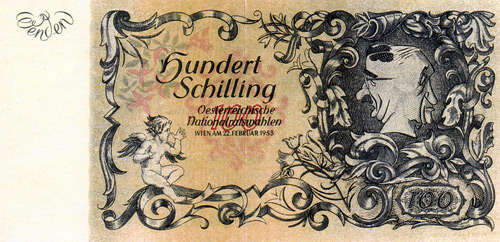
http://www.psywar.org/coldwarcurrency.php

